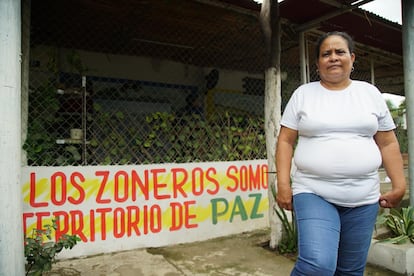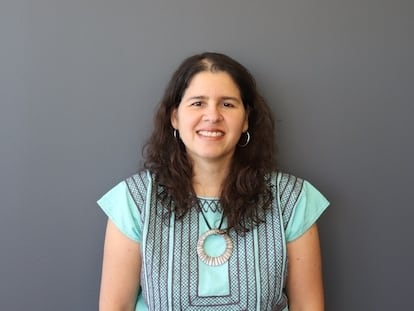Beatriz García: Land resistance in Colombia’s banana epicenter
She leads the Fundapaz Foundation’s ‘El Chimborazo’ campaign, whose goal is to reunite the 112 families who lost their lands to paramilitary groups. She turned her pain into art and is a voice for the culture of peace

Among the one-story houses in the township of Orihueca, located in the municipality of Zona Bananera in the Colombian department of Magdalena, there is one structure that stands out. Located a few blocks from the train tracks, its large patio is full of tables where people play dominoes and meals featuring bananas and plantains are served. Its roof is made with a layer of zinc and another of matting comprised of the straw obtained on the shores of the nearby swamp, with which local residents also make their mattresses.
At the entrance, on a low white wall, a phrase is written in red-and-green letters that aptly sums up the battle being waged by the woman who is the soul of this home, Beatriz Helena García Lechuga: “We locals are a territority of peace.”
The fingers on the right hand of García, who is the leader of the Fundapaz Foundation’s “El Chimborazo” campaign, travel up her right arm, stroking the scars of the stab wounds that remind her of the torture to which she was subjected. Then she rubs her hands together, as if she was lighting a fire, willing herself the strength to talk about all that has happened to her in this fight.
García Lechuga says that when she tells people that she lives in Orihueca, some scratch their head and look away, or exclaim, “Oh, it’s dangerous there!” “We aren’t dangerous, the damage is being done by people who aren’t from here. We want to show the country that in this town, we are peaceful people,” she says.
Zona Bananera, which has 14 townships and 46 villages, was established as a municipality in 1999. Prior to that, it was considered part of Ciénaga, the epicenter of the banana business, which ushered in the multinational corporations and violence that has now roiled the region for decades.
For context: Orihueca was the original site of the Compañía Frutera de Sevilla (Sevilla Fruit Company), a subsidiary of the United Fruit Company, which was responsible for the Banana Plantation Massacre of 1928, in which, according to historical record, more than a thousand people died.
In this house with its large patio and zinc-and-matting roof, in this house where Beatriz Helena García Lechuga smiles and walks confidently about, these past chapters of horror have been transformed into art. An artist named La Magia has created a symbolic vision of the history of the municipality in three murals, which were funded by the Ministry of Culture, Arts and Knowledge’s “Culture of Peace” campaign.
In her fluid manner of speaking, García Lechuga admires the murals and emphasizes their significance: “We are going to to tell, from another point of view, from another sector, everything that has happened here throughout history.”
Past
On her patio, García Lechuga constantly receives fellow activists. At the end of this month, the space will fill up with more than 100 families who have also suffered from the impacts of events that began to take place in 2000. At that time, 112 families who owned land in the village of Chimborazo, in Pueblo Viejo, had organized and implemented a hybrid corn project with the support of the agrarian bank. “These were virgin territories. Imagine — it was a hit!” recalls the leader.
This love of the land is represented in the first mural on the left, which portrays two oxen, previously the area’s primary means of transportation. The animals pull wagons and around them unfolds fertile land, irrigated by a crystalline stream. “Those animals were a means of employment for us, they brought strength and endurance to our work as farmers,” says García Lechuga.
Tragedy began for these 112 families when “those men” — which is how García Lechuga refers to the paramilitaries from the United Self-Defense Forces of Colombia (AUC)’s William Rivas Front of the North Block — arrived in the area and gave its residents 24 hours to leave. She was their first victim.
The paramilitaries also sexually abused 37 people from the community, including boys, girls, men and women. “Two years ago, I had an operation, they had to remove part of my uterus… They did a lot of evil to us… It hurts, but, well, hopefully people understand that the war over this piece of land has been very hard on us,” she says.
After the Banana Plantation Massacre of 1928, the banana industry in Colombia has continued to leave a bloody trail. In fact, a Florida judge recently ordered Chiquita Brands (formerly United Fruit Company) to compensate victims of paramilitary groups in the Urabá Antioquia and Magdalena Medio sub-regions. The company has already confessed to having financed the AUC between 1997 and 2004.
The William Rivas Front, for example, was funded by banana companies and received weapons that arrived via the port belonging to Chiquita in the Urabá.
Beyond this violence, Orihueca has a profound relationship to literature. They say that the great Colombian Gabriel García Márquez had an uncle and cousin in the township who he used to visit. In his book Living to Tell the Tale, the writer tells of how on a train journey from Santa Marta, after passing through Río Frío, Orihueca and Guacamayal, he saw a sign for a farm that would inspire the name of the imaginary town in his masterpiece novel: Finca Macondo.
Macondo indeed appears on maps just outside Orihueca, near Sevilla. It is a small train station with two haciendas from the United Fruit Company era.
One of Beatriz’s fellow activists, the educator and historian Juan Escobar Martínez, tells of how in 1928, in Orihueca, there were Jamaican-style houses built with materials sourced from abroad. Escobar agrees with García Lechuga that the township’s residents are much more than their history of violence. “We are happy here, we are tenacious. Our banana fields, which we have all around us, are green, which is the color of hope and peace,” he says.
Present
In the second mural, the center one, a naked woman with long black hair stands out. Around her are hummingbirds and icons, as well as a vast sky in which blue and white intermingle. “You see the scene there, a woman resisting, a woman who could be Mother Earth. That is us women, the ones who fight and cry and long for the land,” says García Lechuga.
One of these women is her fellow activist Ligia Isabel Conrado Polo, who is also part of the “El Chimborazo” campaign and who had to flee her land when the paramilitaries arrived. “It’s been 24 years of struggle and here we are, strong. Fearful, but here we are,” says Conrado, who says that during their escape from their land, by night, her husband took a branch to his left eye that detached his retina. Ultimately, he lost the eye.
Conrado Polo has fought alongside García Lechuga in this struggle for more than 20 years, during which time they have testified about their situation to different authorities, received support from institutions like the Norwegian Refugee Council, the UN, and the Colombian government’s Victims Unit. Now, they are in the process of working with the country’s Land Agency to recover the plots that the war took from them. “Some of our peers are already dying and nothing is happening, they are still not giving us the land,” says Conrado Polo, who was born in Guacamayal.
Future
In the third mural, on the righthand side of the patio, a great ox is accompanied by rabbits, a dove, massive banana plants and the branches that are used to stack corn and rice. “We want women and men to return to our territory as farmers and for it to be a symbol of peace,” says García Lechuga.
In the Collective’s Integral Reparation Plan that the community presented to the Victims Unit, and which they plan to implement once the lands are handed over to them, the group proposes a productive food processing project that they have been developing with the National Apprenticeship Service (SENA) and the University of Magdalena. They would use raw materials like the popocho plantain, bananas, and standard plantains.
Looking towards the future, to the meeting that will take place at the end of the month, García Lechuga says that she will make a community stew for the more than 100 guests. They will play dominoes and soccer, weave, and share stories. “People are getting tired of waiting. Imagine, we’ve been going since 2000 and there’s been nothing about the lands, nothing about compensation. But we are going to start again, organize,” she says.
Sign up for our weekly newsletter to get more English-language news coverage from EL PAÍS USA Edition
Tu suscripción se está usando en otro dispositivo
¿Quieres añadir otro usuario a tu suscripción?
Si continúas leyendo en este dispositivo, no se podrá leer en el otro.
FlechaTu suscripción se está usando en otro dispositivo y solo puedes acceder a EL PAÍS desde un dispositivo a la vez.
Si quieres compartir tu cuenta, cambia tu suscripción a la modalidad Premium, así podrás añadir otro usuario. Cada uno accederá con su propia cuenta de email, lo que os permitirá personalizar vuestra experiencia en EL PAÍS.
¿Tienes una suscripción de empresa? Accede aquí para contratar más cuentas.
En el caso de no saber quién está usando tu cuenta, te recomendamos cambiar tu contraseña aquí.
Si decides continuar compartiendo tu cuenta, este mensaje se mostrará en tu dispositivo y en el de la otra persona que está usando tu cuenta de forma indefinida, afectando a tu experiencia de lectura. Puedes consultar aquí los términos y condiciones de la suscripción digital.
More information
Archived In
Últimas noticias
Aquilino Gonell, former Capitol sergeant: ‘If it hadn’t been for the police, the US would be a dictatorship’
A hybrid building: Soccer pitch, housing, and a shopping mall
Europe urges Trump to respect Greenland following annexation threats
Science seeks keys to human longevity in the genetic mixing of Brazilian supercentenarians
Most viewed
- Alain Aspect, Nobel laureate in physics: ‘Einstein was so smart that he would have had to recognize quantum entanglement’
- Mexico’s missing people crisis casts a shadow over World Cup venue
- Alvin Hellerstein, a 92-year-old judge appointed by Bill Clinton, to preside over Maduro’s trial in New York
- Why oil has been at the center of Venezuela-US conflicts for decades
- Cuba confirms death of 32 of its citizens in the US attack against Venezuela









































